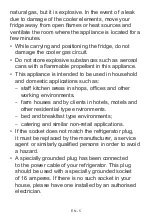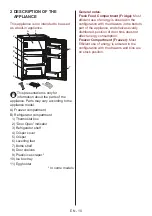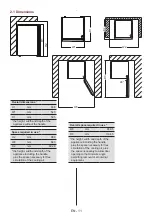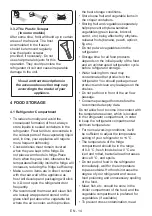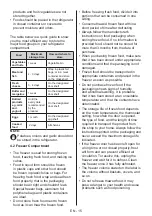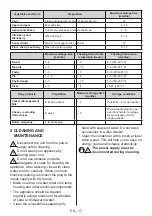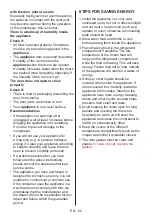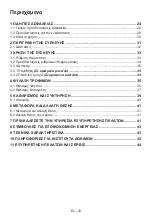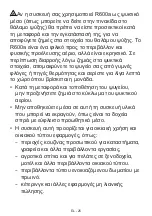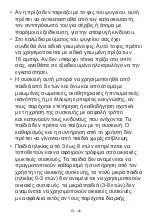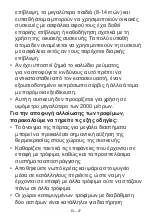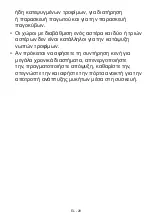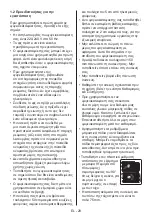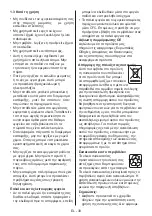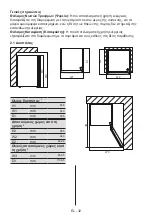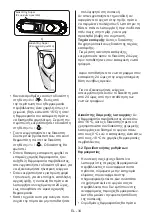
EN - 19
to the mains supply and leave for 2 to
3 hours on setting number MAX before
introducing the food back into the freezer.
Replacing LED Lighting
To replace any of the LEDs, please contact
the nearest Authorised Service Centre.
Note:
The numbers and location of the
LED strips may change according to
the model.
6 SHIPMENT AND
REPOSITIONING
6.1 Transportation and Changing
Positioning
•
The original packaging and foam may be
kept for re-transportation (optional).
• Fasten your appliance with thick
packaging, bands or strong cords and
follow the instructions for transportation
on the packaging.
• Remove all movable parts or fix them
into the appliance against shocks
using bands when re-positioning or
transporting.
Always carry your appliance in the
upright position.
6.2 Repositioning the Door
•
It is not possible to change the opening
direction of your appliance door if door
handles are installed on the front surface
of the appliance door.
•
It is possible to change the opening
direction of the door on models
with
hand
l
e on the side of the door or without
handles
.
•
If the door-opening direction of your
appliance can be changed, contact the
nearest Authorised Service Centre to
change the opening direction.
7 BEFORE CALLING AFTER-
SALES SERVICE
If you are experiencing a problem with
your
appliance
, please check the following
before contacting the after-sales service.
Your appliance is not operating
Check if:
• There is power
•
The plug is correctly placed in the socket
•
The plug fuse or the mains fuse has
blown
•
The socket is defective. To check this,
plug another working appliance into the
same socket.
The appliance performs poorly
Check if:
•
The appliance is overloaded
•
The appliance door is closed properly
•
There is any dust on the condenser
•
There is enough space near the rear and
side walls.
Your appliance is operating noisily
Normal noises
Cracking noise occurs:
•
During automatic defrosting
•
When the appliance is cooled
or warmed (due to expansion of
appliance material).
Short cracking noise occurs:
When
the thermostat switches the compressor
on/off.
Motor noise:
Indicates the compressor
is operating normally. The compressor
may cause more noise for a short time
when it is first activated.
Bubbling noise and splash occurs:
Due to the flow of the refrigerant in the
tubes of the system.
Water flowing noise occurs:
Due
to water flowing to the evaporation
container. This noise is normal during
defrosting.
Air blowing noise occurs:
In some
models during normal operation of the
system due to the circulation of air.
The edges of the appliance in contact
Summary of Contents for W72121SD
Page 1: ...W72121SD REFRIGERATOR USER MANUAL...
Page 22: ...EL 22...
Page 24: ...EL 24 1 1 1...
Page 25: ...EL 25 R600a R600a...
Page 26: ...EL 26 16 8 3 8 0 3 3 8...
Page 27: ...EL 27 8 14 2000...
Page 28: ...EL 28...
Page 29: ...EL 29 1 2 220 240 V 50 Hz AC 50 cm 5 cm 2 cm 150 mm 90 75 mm...
Page 30: ...EL 30 1 3 CFC CE...
Page 31: ...EL 31 2 1 A 2 3 4 5 6 7 8 9 10 11 B A B 1 2 3 4 5 6 7 8 9 10 11...
Page 33: ...EL 33 3 3 1 1 3 1 5 SF 1 Super 1 2 3 4 5 SF SF SF SF SF 3 Super...
Page 34: ...EL 34 Super Super 0 16 C 1 1 Super 24 5 24 24 24 16 o C 0 o C 18 o C 3 2...
Page 35: ...EL 35 24 5 5 T 16 C 43 C ST 16 C 38 C N 16 C 32 C SN 10 C 32 C 3 3 3 3 1 3 3 2 4 4 1...
Page 36: ...EL 36 4 C 0 8 C 0 C 8 C 1 2 3 3 4 1 1...
Page 37: ...EL 37 2 4 2 3...
Page 40: ...EL 40 5 1...
Page 41: ...EL 41 24 2 3 MAX LED LED LED 6 6 1 6 2 7...
Page 42: ...EL 42 5...
Page 44: ...EL 44 11 PNC 7 10 www morris gr...
Page 46: ...52350665...

